Annona coriacea is a fruit tree native to Brazil. Its original habitat includes the ecoregions of Cerrado, Caatinga, and Pantanal. There, it is typically found in scrublands and savannahs, though it is sometimes grown in orchards. Its wood is used in constructions and toys. This plant is cited in Flora Brasiliensis by Carl Friedrich Philipp von Martius.

Bidens pilosa is an annual species of herbaceous flowering plant in the daisy family Asteraceae. Its many common names include hitch hikers, black-jack, beggarticks, farmer's friends and Spanish needle, but most commonly referred to as cobblers pegs. It is native to the Americas but is widely distributed as an introduced species in other regions including Eurasia, Africa, Australia, South America and the Pacific Islands, and is classified as an invasive species in some regions of the world.
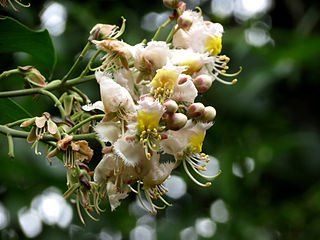
Hiptage benghalensis, often simply called hiptage, is a perennial, evergreen liana native to India, Southeast Asia, Taiwan, and the Philippines. Its habitat is variable and prefers climates ranging from warm temperate to tropical. In Hawaii, where H. benghalensis is considered a weed, as it is in Australia, Mauritius and Réunion, it grows from sea level to 1,000 m (3,281 ft). H. benghalensis is cultivated for its white-pink scented flowers.

Verbena bonariensis, the purpletop vervain, clustertop vervain, Argentinian vervain, tall verbena or pretty verbena, is a member of the verbena family cultivated as a flowering annual or herbaceous perennial plant. In United States horticulture, it is also known by the ambiguous names purpletop and South American vervain. For the misapplication "Brazilian verbena" see below.

Erechtites hieraciifolius is a plant in the daisy family, Asteraceae. It is native to the Americas, but is found many places around the world having been introduced by human activity. such as in Hawaii, China, Europe and Southeast Asia.

Erechtites is a genus of flowering plants in the daisy family known commonly as fireweeds or burnweeds. They are native to the Americas and Australia, but some species are widely distributed weeds.
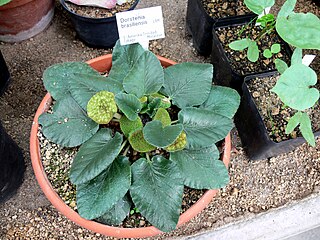
Dorstenia brasiliensis is a species of herbaceous plant in the family Moraceae of the order Rosales.

Antigonon leptopus is a species of perennial vine in the buckwheat family commonly known as coral vine or queen's wreath. This clambering vine is characterized by showy, usually pink flowers that can bloom throughout the year and large, heart-shaped leaves. A. leptopus is native to the Pacific and Atlantic coastal plains of Mexico, but also occurs as a roadside weed from Mexico south to Central America. It is widely introduced and invasive throughout tropical regions of the world, including in the south and eastern United States, the West Indies, South America, and the Old World tropics of Asia and Africa. This species is utilized for its edible tubers and seeds, but also for its horticultural properties as an ornamental vine in warmer parts of the world.
Ixophorus is a genus of Latin American plants in the grass family. The only recognized species is Ixophorus unisetus. Some authors have included one or two other species in the genus, such as I. pringlei, but these have more recently been reduced to synonymy. Common names for I. unisetus include crane grass, turkey grass, Honduras grass, Mexican grass, Central America grass, hático (Colombia), zacate blanco, and zacate chompipe (Nicaragua).

Rubus ulmifolius is a species of wild blackberry known by the English common name elmleaf blackberry or thornless blackberry and the Spanish common name zarzamora. It is native to Europe and North Africa, and has also become naturalized in parts of the United States, Australia, and southern South America.
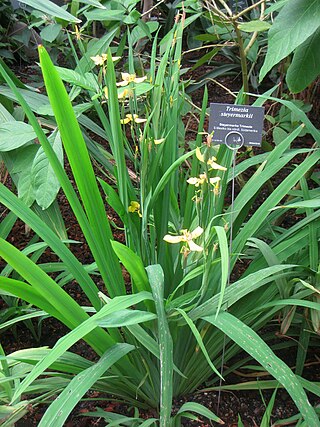
Trimezia steyermarkii is a species of flowering plant in the family Iridaceae, native to southern Mexico, Central America, Colombia, and Venezuela. Plants are up to 150 cm tall, with rhizomes up to 2–4 cm long and 2–3 cm wide; leaves are lanceolate, 60–150 cm long by 2 cm wide; flowers are yellow with brown spots. In countries like Colombia and Venezuela, a name that is often given to this plant is "Hand of God" because of the three flower petals.

Sanicula crassicaulis is a species of flowering plant in the family Apiaceae known by the common names Pacific black-snakeroot and Pacific sanicle.

Ruellia tuberosa, also known as minnieroot, fever root, snapdragon root and sheep potato, is a species of flowering plant in the family Acanthaceae. Its native range is in Central America but it has become naturalized in Africa, South and Southeast Asia.
Some species endemic to New Zealand are causing problems in other countries, similar to the way introduced species in New Zealand cause problems for agriculture and indigenous biodiversity.
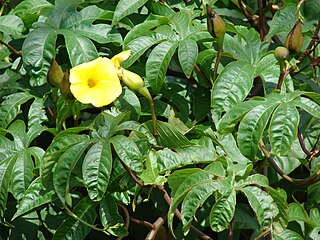
Distimake tuberosus, also known as Spanish arborvine or wood rose, is a vine in the family Convolvulaceae. It is native to the Americas, from Florida and Texas to Brazil, although considered by the USDA as introduced to the United States. It is an invasive species in a number of islands in the Indian and Pacific Ocean, such as New Caledonia.

Richardia brasiliensis is a species of flowering plant in the coffee family known by the English common names tropical Mexican clover, Brazilian calla-lily, white-eye, and Brazil pusley. In Brazil it is known as poaia branca. It is native to South America. It is an introduced species and sometimes an invasive weed in many other places, including Hawaii, Indonesia, Japan, and Thailand. It is a weed of citrus groves in Florida.
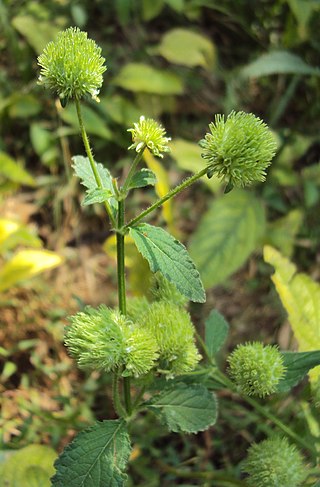
Hyptis capitata, also known as false ironwort or knobweed, is a species of erect annual shrubs, of the plant family Lamiaceae. It is native to Florida, Mexico, Central America, the West Indies, and South America but naturalized in Australia, Southeast Asia, and some tropical islands. The plants grow up to a height of 1.5 meters. Crushed leaves are applied to cuts. It is considered a weed in many places.

Stachytarpheta cayennensis is a species of flowering plant in the verbena family known by many English language common names, including blue snakeweed, Cayenne snakeweed, dark-blue snakeweed, bluetop, nettle-leaf porterweed, rattail, rough-leaf false vervain, blue rat's tail, Brazilian tea, Cayenne vervain, false verbena, joee, nettleleaf velvetberry, and Cayenne porterweed. Names in other languages include honagasō (Japanese), gervão-urticante, piche de gato, rabo de zorro (Spanish), herbe à chenille, herbe bleue, queue de rat (French), ōi or ōwī (Hawaiian), sakura or ouchung (Chuukese), and tiāki (Māori). It is native to the Americas, from Mexico south through Central and South America to Argentina, as well as many islands of the Caribbean. It is known in many other parts of the world as an introduced species, including regions in Africa, India, Indonesia, Australia, Florida in the United States, and many Pacific Islands. Its distribution is now considered pantropical. In many places, such as New Caledonia, it has become an invasive species.

Setaria palmifolia is a species of grass known by the common names palmgrass, highland pitpit, hailans pitpit, short pitpit, broadleaved bristlegrass, and knotroot. It is native to temperate and tropical Asia. It is known elsewhere as an introduced, and often invasive, species, including in Australia, New Zealand, many Pacific Islands, and the Americas.
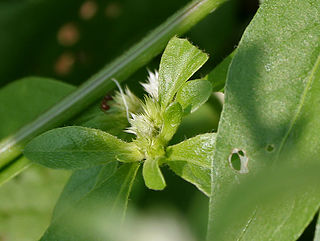
Alternanthera ficoidea, also known as Joseph's coat, Parrot leaf, is a species of flowering plant in the family Amaranthaceae. It is native to the Caribbean and South America and occurs elsewhere in the tropics as an introduced species. It is considered invasive in Palau, the Philippines and Australia (Queensland). Propagation occurs via seeds.
















